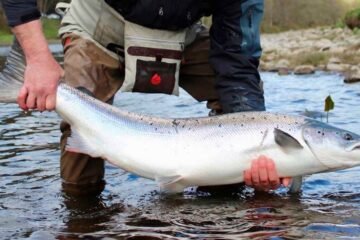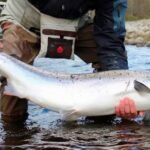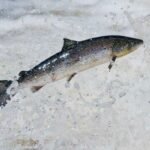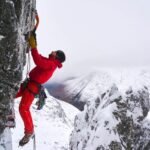They gathered around the water’s edge — some with claws, others with colossal feet, each leaving an imprint in the sand that would outlast time itself.
And 167 million years later, in the cool, salt-stung air of the Isle of Skye, their presence is being felt again.
Researchers have uncovered 131 fossilized dinosaur footprints at a site called Prince Charles’s Point, on the northern tip of Skye. The findings, published last week in PLOS One, offer a rare glimpse into a pivotal moment in the Middle Jurassic, when the dynamics between predator and prey — and between land and sea — were still unfolding.
“This is fossilized behavior,” said paleontologist Mike Benton, speaking to The Washington Post. “Each footprint shows us exactly what a dinosaur was doing so many million years ago.”
From “Fish Burrows” to Theropod Tracks
Locals and geologists alike had long noticed unusual marks in the rock at Prince Charles’s Point — shallow, flat impressions that were largely dismissed as fish burrows.
That changed in 2019.
Tone Blakesley, then a graduate student at the University of Edinburgh, was walking the site when something caught his eye. Amid a sandstone stretch, a three-toed print rose ever so slightly from the surface — distinct, crisp, unmistakable.
“You could see the toes, the claw marks,” Blakesley recalled to The Washington Post. “It was slightly raised and looked weathered, but it was really sharp.”
That one print turned out to be the first clue in a much larger puzzle. Over the next few years, Blakesley and his team would identify over a hundred similar tracks — from herbivorous sauropods to carnivorous theropods — and build a 3D map of the ancient site.

A Prehistoric Oasis Shared by Predators and Prey
What the team discovered was remarkable: multiple species of dinosaurs had used this area not as a hunting ground, but seemingly as a shared watering hole.
-
Theropods — the sharp-toothed, Jeep-sized meat-eaters, ancestors of birds like modern hawks — wandered in on three-toed feet, their claws leaving deep imprints in the ancient mud.
-
Sauropods — lumbering, long-necked herbivores with feet like dinner plates — walked nearby, their massive weight pressing circular impressions into the sediment.
Some tracks overlapped, suggesting these creatures weren’t just passing through separately, but may have visited the site within hours or even minutes of one another.
“It looks like someone has pressed the pause button,” Blakesley told The Guardian. “You close your eyes, and the tides wash back and you’re in the mid-Jurassic. It’s a spine-tingling feeling.”
Jurassic Scotland: A Snapshot in Evolution
The Middle Jurassic is a notoriously underrepresented period in the fossil record. Few sedimentary layers from this era have survived in conditions suitable for fossil preservation, especially in Europe.
That makes this discovery not just visually striking, but scientifically rare.
“These footprints are incredibly valuable,” Blakesley said. “They give us behavioral data — movement, presence, interaction — from a time we know very little about.”
This period, around 164 to 174 million years ago, was one of rapid dinosaur evolution. Massive species diversification was taking place, particularly among theropods, which were developing more birdlike traits.
“This site helps fill a major gap,” said Benton. “It’s almost like finding a missing page in a history book.”
The Map and the Evidence
The research team used 3D photogrammetry and field sketches to record and analyze the site, accounting for erosion, sediment shift, and track overlap. Here’s a quick snapshot of what they found:
| Dinosaur Type | Number of Tracks | Notable Features |
|---|---|---|
| Theropods | ~50 | Three-toed, claw marks, overlapping prints |
| Sauropods | ~70 | Circular impressions, deep indentations |
| Unknown / Partial | 11 | Eroded or incomplete tracks |
Notably, some of the prints show signs of modern-day erosion — worn edges, partial washout — but others are remarkably well-preserved, with visible toe pads and even claw drag.
Was It a Peaceful Gathering?
While it’s tempting to imagine a standoff between predators and prey, the evidence doesn’t support a dramatic chase scene. Blakesley and the research team believe the site was more tranquil than tense — a neutral zone where survival needs took precedence.
“There’s no sign of pursuit or panic,” Blakesley told CNN. “They likely weren’t there at exactly the same time. But close enough.”
Still, the idea of a sauropod quietly drinking just hours after a theropod walked by adds a layer of drama to the data.
“That would be a disaster for the sauropods if they got too close,” Blakesley added. “The temptation for lunch would’ve been too much for the theropods.”
What’s Next for Prince Charles’s Point?
With the study now published, researchers hope to further excavate and protect the site, which faces threats from natural erosion and sea level rise.
And for Blakesley — now a paleontologist in his own right — the tracks remain more than just a scientific find. They’re a reminder of something ancient, yet strangely intimate.
“To put your hand into the sole of a footprint, and know something stood there 167 million years ago?” he said. “That never gets old.”


















